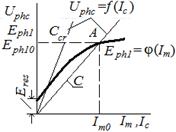FEATURES OF ASYNCHRONOUS GENERATORS OPERATION
Excitation of asynchronous generator is made by two modes − from a network and self-exciting with the help of capacitors. At first mode a rotor of asynchronous machine, powered on, is accelerated by primary engine up to oversynchronous frequency of rotation. A machine operates with the negative sliding, i.е. in the generator mode
s = (п1 — п2)/п1 <0, (1)
where п1 − synchronous frequency of rotation; п2 − frequency of rotor rotation.
For realization of this mode it is needed a consumption from the network of magnetizing current about 25-30% of nominal, that is the substantial lack of asynchronous generator at this method of excitation. In addition, an asynchronous generator, consuming a  magnetizing current, reduces the power factor of network.
magnetizing current, reduces the power factor of network.
 Another way of asynchronous generator excitation consists in self-excitation from the residual magnetism of rotor which corresponds to E.M.F. Eres. In this case the battery of capacitors (fig. 1, а) is Fig. 1, a connected to terminals of machine. Increase of voltage at self-excitating goes on up to the intersection of magnetizing curve Еph1 = φ(Im) and CVC of capacitor Uphc = f(Ic) (fig.1, b), where Iт and Iс− magnetizing current and current through capacitor respectively. At constant speed of rotor the o.c. voltage depends only on the value of excitative capacity. Generator is excited, if Fig. 1, b capacity more than critical one, i.e. С>Сcr.
Another way of asynchronous generator excitation consists in self-excitation from the residual magnetism of rotor which corresponds to E.M.F. Eres. In this case the battery of capacitors (fig. 1, а) is Fig. 1, a connected to terminals of machine. Increase of voltage at self-excitating goes on up to the intersection of magnetizing curve Еph1 = φ(Im) and CVC of capacitor Uphc = f(Ic) (fig.1, b), where Iт and Iс− magnetizing current and current through capacitor respectively. At constant speed of rotor the o.c. voltage depends only on the value of excitative capacity. Generator is excited, if Fig. 1, b capacity more than critical one, i.e. С>Сcr.
In the node of curves Еph1 = φ(Im) and Uphc = f(Ic) (point A on a fig. 1) an equilibrium occurs between voltages of generator and capacitors
Ic ω1L1 = Ic / ω1 C, (2)
where L1 = (Хs 1+ Хт)/ω1 − inductance of phase of generator stator winding; Хs1 − inductive resistance of dispersion of stator winding phase; Хm − inductive resistance of magnetizing contour; C − capacity, reduced to phase voltage.
From equality (2) it is possible to define dependence between inductance L1 and required excitative capacity C at given frequency f1 = ω1/2π:
L1 С = 1/ ω12 (3)
f1 = 1 / (2π√ L1 С) (4)
If to accept, that at idling the sliding s = 0, then f1 = f2, where f2 − electric frequency of rotor rotation. In this case
f2 ≈ 1/ (2π√ L1С) (5)
So, at o.c.of asynchronous self-excited generator the parameters of oscillating loop are tuned automatically on frequency, equal to electric frequency of rotor rotation.
 It can consider the different operation modes of generator and calculate by means of equivalent circuit (fig. 2) and vector diagram of voltage (fig. 3).
It can consider the different operation modes of generator and calculate by means of equivalent circuit (fig. 2) and vector diagram of voltage (fig. 3).
 In the equivalent circuit at s < 0 the resistance r2'/s is a generating element. If at loading generator, running on a separate individual network, a frequency Fig. 2 of rotation п2 of primary engine is supported constant, that frequency f1 and voltage Uph 1 will some change at the change of load Zl = Rl +jXl. For maintenance f1 = const at loading it is need to change the speed п2 of generator rotor rotation. Thus it is settled a sliding s, corresponding to this load.
In the equivalent circuit at s < 0 the resistance r2'/s is a generating element. If at loading generator, running on a separate individual network, a frequency Fig. 2 of rotation п2 of primary engine is supported constant, that frequency f1 and voltage Uph 1 will some change at the change of load Zl = Rl +jXl. For maintenance f1 = const at loading it is need to change the speed п2 of generator rotor rotation. Thus it is settled a sliding s, corresponding to this load.
External characteristics of Fig. 3 asynchronous generators are strongly falling and depend on the value of excitant capacity (fig. 4, a, b). The strong voltage diminishing at the terminals of generator with the increase of load is explained by that the increase of internal voltage drop causes diminishing of magnetizing current and E.M.F., induced by the revolved magnetic field in the phase of stator (see a fig. 4.3). By other reason of diminishing . E.M.F. there is a demagnetizing action of secondary contour. External characteristics of asynchronous generators look like, characteristic for the generators of parallel excitation: after achievement by the load current of critical value Icr a turn-over of the external characteristic curve is observed. Thus currents of short circuit are small.